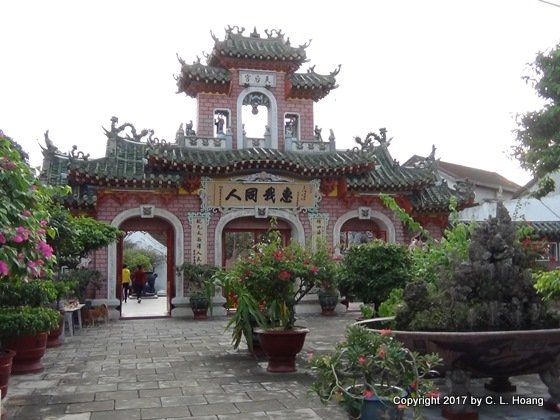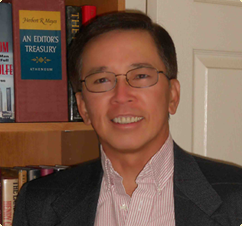A little way down the block, Trí stops in front of what looks like an ornate temple gate. “This is the Phúc-Kiến Assembly Hall, the grandest example of the type of community halls built by Chinese merchants who settled in Hội-An,” he says. “Let’s go in and have a look around, and while we’re here I will pay so we can use their restroom facilities.”
Phúc-Kiến is the Vietnamese-sounding name for Fukien, or Fujian, a Chinese province. Many of the merchants who migrated here had fled from their native provinces in China after the downfall of the Ming Dynasty in 1644. We cross a tiled courtyard decorated with bonsai plants in ceramic pots to enter the sprawling complex, which was founded in 1690. Besides serving as the meeting place for the Phúc-Kiến natives, it also houses a temple to Thiên-Hậu, Goddess of the Sea, who is regarded as the protector of sailors. Her statue presides over the main altar in the elaborate front hall, flanked by her two assistants: the goddess Thuận-Phong-Nhῖ, who is said to be able to hear the sound of a shipwreck from a thousand miles away; and Thiên-Lý-Nhãn, the goddess who can see that distant ship in distress. To the right of the altar is a detailed model of the sailing junk that was used in the initial sea crossing from Phúc-Kiến to Việt-Nam. Various symbolic and mythical animals—fish, turtle, unicorn, dragon, phoenix—are prominently featured in sculptures and fountains scattered throughout the temple.

Hearing commotion in the courtyard, I round back to the front to witness the women in my tour group clinging to each other, bent over with laughter. They’re all gathered outside the women’s facility, its door flung open, with Trí standing to the side holding a roll of toilet paper for anyone who may need it, as he always does at every rest stop. The woman next to me tries to explain between nervous chortles. “Valerie, she was in there taking care of business while the rest of us waited out here, when all of a sudden we heard a loud shriek. Then she came barging out, white as a sheet. She . . . she . . .” The woman shudders and makes a face. “This nasty cockroach had landed right on her shoulder! Long whiskers it had, too. . . . We all just flipped out. Thank goodness someone grabbed her and flicked the darned thing off of her.”
After the excitement subsides, we leave the assembly hall and continue down the street. It feels like a sweltering summer fair as we rejoin the throngs of visitors and saunter past shops, restaurants, and outdoor cafés along the roadsides. Also vying for a piece of the business are women street vendors who carry, bowing under the weight, their precious load of homemade food in baskets that swing from their shoulder pole. Even though Trí has warned us about street food, a couple of women from our group still stop to buy from these vendors. “Just to help them out a little,” they say with a kind smile.
At the end of the street, we arrive before a narrow gate-like entrance with a tile roof over it. “We are now at the best-known landmark of Hội-An, considered by many its emblem,” says Trí. “The Japanese Covered Bridge, also called Chùa Cầu, which means ‘Bridge Pagoda.’ You cross the bridge from this entrance in order to reach the old Japanese quarter on the other side.”



Leave a Reply